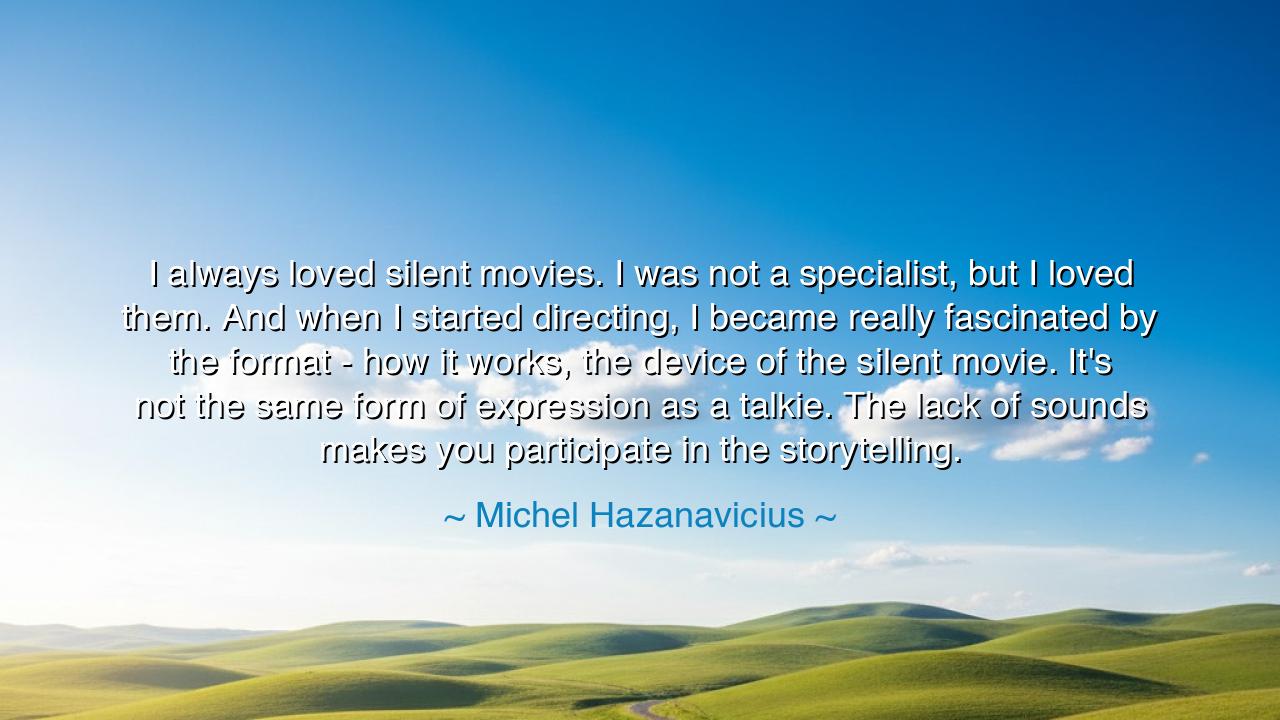
I always loved silent movies. I was not a specialist, but I
I always loved silent movies. I was not a specialist, but I loved them. And when I started directing, I became really fascinated by the format - how it works, the device of the silent movie. It's not the same form of expression as a talkie. The lack of sounds makes you participate in the storytelling.






"I always loved silent movies. I was not a specialist, but I loved them. And when I started directing, I became really fascinated by the format - how it works, the device of the silent movie. It's not the same form of expression as a talkie. The lack of sounds makes you participate in the storytelling." These words from Michel Hazanavicius, the director of The Artist, reveal a deep reverence for the silent film era and the unique artistry it demanded from filmmakers and actors. Hazanavicius' fascination with silent cinema speaks to the power of simplicity—how the absence of sound in a film forces the audience to engage with the visual elements in a more profound and active way. It is a return to an era when storytelling relied solely on expression, movement, and imagery, requiring a closer connection between the film and its audience. In many ways, silent cinema strips away the distractions of dialogue, leaving the story to be told through pure emotion and visual communication.
Silent films, born at the dawn of cinema, represent a time when the medium was still in its infancy. Actors like Charlie Chaplin, Buster Keaton, and Mary Pickford mastered the art of physical expression, using their faces and bodies to convey emotions that words could not capture. In these films, the audience did not simply watch—they participated in the storytelling. There was no voice to fill the space; instead, the characters' movements, the way they interacted with their surroundings, and the visual symbols used on screen became the language of the film. Hazanavicius’s quote emphasizes this notion: without sound, the viewer is not a passive observer but an active participant in interpreting the emotions and narrative unfolding before them.
The magic of silent cinema lies in its ability to transcend language barriers. A story told without words speaks directly to the universal human experience. For example, consider Chaplin’s famous film City Lights, where his character, the Tramp, communicates more through his gestures and expressions than any dialogue could ever convey. The emotional resonance of the film, which portrays love, loss, and compassion, is understood by all, regardless of language or cultural background. In this way, silent films bridge the divide between people, allowing them to connect on a deeper, more fundamental level. Hazanavicius, too, taps into this power with The Artist, a modern-day tribute to silent cinema, capturing the timeless beauty of this storytelling tradition.
There is a wisdom in Hazanavicius' reflection that transcends cinema itself. In our modern world, we often find ourselves overwhelmed by the noise and distractions around us. The rapid pace of life, the constant flood of information, and the overwhelming presence of digital media can drown out the subtler, more meaningful expressions of life. Silent cinema, in its purity, reminds us of the power of simplicity and the importance of focus. When stripped of external noise, we are able to pay deeper attention to the details that often go unnoticed—the subtle movements, the fleeting expressions, and the silences between the words. It calls on us to engage more fully with the world around us, to listen and feel more deeply rather than simply hearing or seeing in passing.
In the ancient world, we are reminded of how storytelling has always been a means of passing down knowledge, culture, and human emotion. The Greek tragedies and epic poems of Homer were often performed in ways that demanded the audience’s complete focus—the words, gestures, and emotions conveyed by actors were not just entertainment, but a means of learning, growing, and reflecting on the human condition. In many ways, the silent film era served as a modern reflection of this tradition, asking the audience to engage emotionally and intellectually with the story. Hazanavicius’ admiration for this form of cinema is a call to return to a more active participation in our experience of art and life.
The lesson here is clear: to engage with the world, we must often seek to strip away the layers of complexity and noise that surround us. Whether in art, communication, or life itself, we are often most moved by the simple, the unspoken, and the visceral. As Hazanavicius suggests, the lack of sound in silent movies makes the viewer a co-creator in the storytelling process. Similarly, in our own lives, we can cultivate a deeper understanding by turning off the external distractions and engaging deeply with what is before us. In our conversations, our relationships, and even in our work, there is great value in quieting the noise, in allowing ourselves the space to truly listen, to observe, and to feel the subtle nuances that define our experiences.
In practical terms, this lesson calls us to slow down and embrace the art of simplicity. When was the last time we took a moment to simply observe without rushing to fill the silence with words or distractions? How often do we allow ourselves the space to truly listen, to appreciate the non-verbal cues, and to connect on a deeper level? In our daily lives, we can create opportunities to engage more meaningfully by taking the time to focus on the unspoken, to embrace moments of stillness, and to allow ourselves to participate fully in the unfolding stories of those around us. The silence, in all its beauty, offers a path to a richer, more engaged existence.






AAdministratorAdministrator
Welcome, honored guests. Please leave a comment, we will respond soon